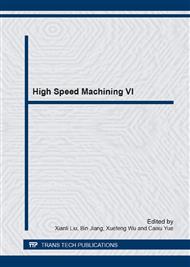[1]
Edward M. Trent, P.K.W., Metal Cutting(fourth edition). (2000).
Google Scholar
[2]
A. Senthil Kumar, A.R.D., T. Sornakumar, Wear behaviour of alumina based ceramic cutting tools on machining steels. Tribology International, 2006. 39: pp.191-197.
DOI: 10.1016/j.triboint.2005.01.021
Google Scholar
[3]
Deng Jianxin, L.L., Liu Jianhua, Zhao Jinlong, Yang Xuefeng, Failure mechanisms of TiB2 particle and SiC whisker reinforced Al2O3 ceramic cutting tools when machining nickel-based alloys. International Journal of Machine Tools & Manufacture, 2005. 45: pp.1393-1401.
DOI: 10.1016/j.ijmachtools.2005.01.033
Google Scholar
[4]
J. Barry, G.B., Cutting tool wear in the machining of hardened steels Prat 1: alumina/TiC cutting tool wear. Wear, 2001. 247: pp.139-151.
DOI: 10.1016/s0043-1648(00)00531-7
Google Scholar
[5]
Jun Zhao, X.Y., Yonghui Zhou, Cutting performance and failure mechanisms of an Al2O3/WC/TiC micro-nano-composite ceramic tool. Int. Journal of Refractory Metals & Hard Materials, 2010. 28: pp.330-337.
DOI: 10.1016/j.ijrmhm.2009.11.007
Google Scholar
[6]
S.Y. Luo, Y.S.L., Y.Y. Tsai, Wear characteristics in turning high hardness alloy steel by ceramic and CBN tools. journal of Materials Processing Technology, 1999. 88: pp.114-121.
DOI: 10.1016/s0924-0136(98)00376-8
Google Scholar
[7]
W. Grzesik, Z.Z., Wear phenomenon in the hard steel machining using ceramic tools. Tribology International, 2008. 41: pp.802-812.
DOI: 10.1016/j.triboint.2008.02.003
Google Scholar
[8]
G. Brandt, M.M., An electron microprobe and cathodoluminescence study of chemical reactions between tool and work piece when turning steel with alumina-based ceramics. Wear, 1987. 115: pp.243-63.
DOI: 10.1016/0043-1648(87)90215-8
Google Scholar
[9]
al, D.J. e., Wear and lubrication of ceramic cutting tools tool engineering, 2001. 35: pp.3-6.
Google Scholar
[10]
H, X., Wear behavior and wear mechanism of ceramic tools in machining hardened alloy steel. Wear, 1990. 139: pp.439-51.
DOI: 10.1016/0043-1648(90)90061-e
Google Scholar
[11]
L.A. Dobrzanski, K.G., J. M IKula, D. Pakula, Cutting ability improvement of coated tool materials. journal of achievements in materials and manufacturing engineering, 2006. 17(1-2): pp.41-44.
Google Scholar
[12]
F. Klocke, Improved Cutting Processes with Adapted Coating System. (1998).
Google Scholar
[13]
F. Klocke, T.K., Coated tools for metal cutting -features and applications. (1999).
Google Scholar
[14]
w. Grzesik, The role of coatings in controlling the cutting process when turning with coated indexable inserts. Journal of Materials Processing Technology, 1998. 79: pp.133-143.
DOI: 10.1016/s0924-0136(97)00491-3
Google Scholar
[15]
W. Grzesik, J.M., Documentation of toolwear progress in the machining of nodular ductile iron with silicon nitride-based ceramic tools. Cirp Annals - Manufacturing Technology, 2011. 60: pp.121-124.
DOI: 10.1016/j.cirp.2011.03.083
Google Scholar
[16]
J.L. He, C.K.C., M.H. Hon, Wear of Ti-Si-N coated ceramic cutting inserts. wear, 1995. 181-183: pp.189-193.
DOI: 10.1016/0043-1648(94)07050-4
Google Scholar
[17]
M. Sokovic, J.M., . Cutting properties of the al2o3+sic(w) based tool ceramic reinforced with the PVD and CVD wear resistant coatings. journal of materials processing technology, 2005. 164-165: pp.924-929.
DOI: 10.1016/j.jmatprotec.2005.02.071
Google Scholar
[18]
L.A. Dobrzanski, D.P., A. Kriz,M. Sokovic,J. Kopac, Tribological properties of the PVD and CVD coatings deposited onto the nitride tool ceramics. journal of materials processing technology, 2006. 175: pp.179-185.
DOI: 10.1016/j.jmatprotec.2005.04.032
Google Scholar
[19]
M. Sokovic, B.B., S. Sladic, Model of quality management of hard coatings on ceramic cutting tool. journal of Materials Processing Technology, 2009. 209: pp.4207-4216.
DOI: 10.1016/j.jmatprotec.2008.11.026
Google Scholar
[20]
Hsyi-En Cheng, M. -H.H., Influence of TiN coating thickness on the wear of Si3N4-based cutting tools. Surface & Coatings Technology, 1996. 81: pp.256-261.
DOI: 10.1016/0257-8972(95)02535-9
Google Scholar
[21]
Hezhuo Miao, F.S., Zhijian Peng, Size Yang, Chizi Liu, Longhao Qi Nanometer grain titanium carbonitride coatings with continuously graded interface onto silicon nitride cutting tools by pulsed high energy density plasma. Materials Sciecce and Engineering 2004. A 384: pp.202-208.
DOI: 10.1016/j.msea.2004.06.005
Google Scholar
[22]
Taguchi S P, R.S., Silicon nitride oxidation behavior at 1000 and 1200℃. Materials proc technol, 2004. 147: pp.336-342.
Google Scholar


